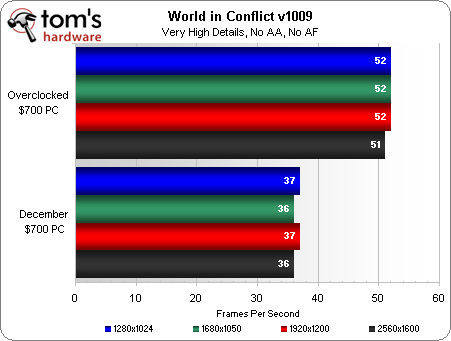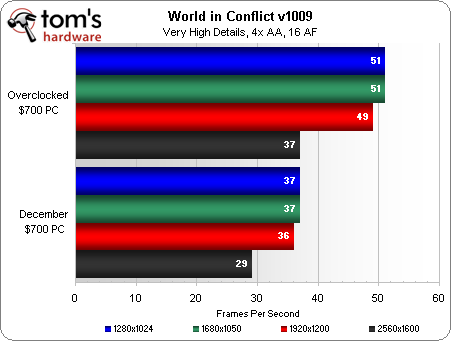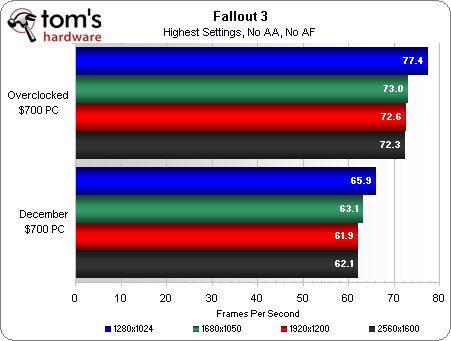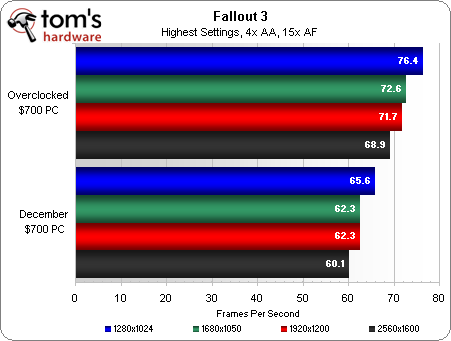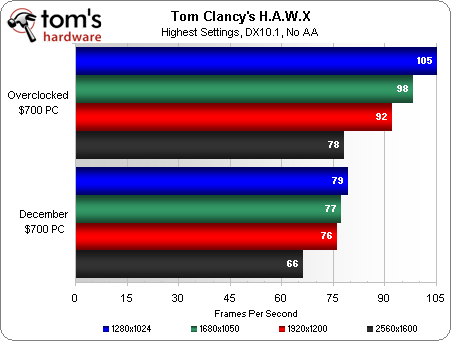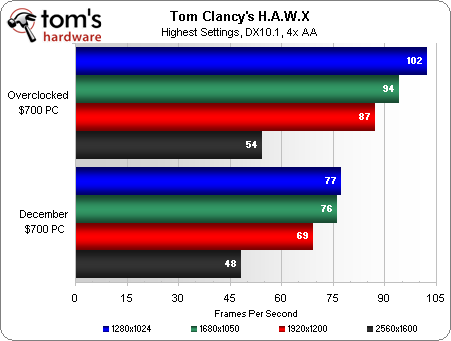System Builder Marathon, Dec. 2009: $700 Gaming PC
Benchmark Results: World In Conflict, Fallout 3, And Tom Clancy’s H.A.W.X.
Overclocking provides a massive 42% increase in performance, although it’s clear we’re dealing with an equally massive system limitation at these settings.
Enabling anti-aliasing (AA) and 16x anisotropic filtering (AF) doesn’t impact performance of the stock $700 PC all the way up to 1920x1200. In fact, even the overclocked system only takes a two frame per second (FPS) hit when enabling eye candy at 1920x1200. At 2560x1600, these Radeon HD 4870s do far better than the Radeon HD 4850s in the September PC build, although some choppiness could result from using cards with a 512MB frame buffer.
Averaging over 60 FPS with minimums in the mid 30s, the stock $700 PC offers very playable performance in Fallout 3. At these settings, the overclocked $700 machine struggles to keep up with the stock PC from September.
Once again, the stock PC offers playable performance, although minimum frame rates now fall to the same 26 FPS as the overclocked September $650 PC did. The true power of the HD 4870s isn’t seen until 2560x1600, when the overclocked $700 system trounces the September system in both average and minimum FPS.
This test is highly graphics-oriented, as the overclocked September PC only keeps up with the stock December machine up until 1680x1050. Overclocking the CPU, FSB, and Radeon HD 4870s yields an average performance increase of 25% for this month’s system.
There is no question that the December PC wins at this game thanks to the more powerful graphics solution. While average frame rates at 2560x1600 were respectable this month and almost double what was seen with the September PC, we still couldn’t call the experience with these 512MB cards completely smooth.
Get Tom's Hardware's best news and in-depth reviews, straight to your inbox.
Current page: Benchmark Results: World In Conflict, Fallout 3, And Tom Clancy’s H.A.W.X.
Prev Page Benchmark Results: Crysis And Far Cry 2 Next Page Benchmark Results: Audio/Video Encoding-
shadowryche Must be something wrong with my ThermalTake Toughpower 750watt, because even that had trouble running a pair of Radeon 4870 512mb cards in crossfire under heavy load. And I only had two hard drives and one optical drive. The only other expansion card I ran was a Wireless N card.Reply -
noob2222 Wish there was an included SBM September in the charts, or at least a link to it. http://www.tomshardware.com/reviews/amd-gaming-pc,2424.html If the numbers are consistent, and seeing how W7 is slightly faster, the september build is a tad faster with less graphic power and $50 less in the build. With the exception of max resolution, and thats the graphics card difference doing the work.Reply
Add in the new AMD options, http://www.tomshardware.com/reviews/athlon-ii-x3,2452.html, wich takes the lead for the most part over the Phenom II x2 550, I am suprised you opted for the intel chip.
That is unless you plan on doing SBMs alternating wich manufacturer is used.
Athlon II 435 with 2 4870s would kill this build at the same price. -
qwertymac93 So we are back to an intel only marathon again. i guess it was silly of me to expect at least ONE system to have an amd cpu in it. it would have been interesting to see the athlon 620+ddr3 be put in the $700 pc, it would have been a nice "are 4 better then 2?" comparison with Septembers build. would have been nice to see dual 5750s in the $700 pc too, but availability and bla bla, i know. with all those modifications though, it would have been closer to a $800pc :(. On a side note, any thoughts on nzxt beta evo vs antec two hundred?Reply -
darthfett It seems to me that in a budget computer, you are not going to be paying huge amounts for a large monitor. Why use 2 graphics cards when one will do for a smaller monitor. Games these days are still pretty CPU heavy.Reply -
rdawise noob2222Wish there was an included SBM September in the charts, or at least a link to it. http://www.tomshardware.com/review ,2424.html If the numbers are consistent, and seeing how W7 is slightly faster, the september build is a tad faster with less graphic power and $50 less in the build. With the exception of max resolution, and thats the graphics card difference doing the work.Add in the new AMD options, http://www.tomshardware.com/review ,2452.html, wich takes the lead for the most part over the Phenom II x2 550, I am suprised you opted for the intel chip. That is unless you plan on doing SBMs alternating wich manufacturer is used.Athlon II 435 with 2 4870s would kill this build at the same price.Reply
You beat me to this.
Have to wonder why the author used a dead socket with no upgrade path. -
snorojr 5750 availability problem ???? you gottas be joking, i had no problem having my hd 5770 while the 5850 where nowhere findable. They could seriously have took the 57xx serie route and the 5750 and 5770 are doing very good in crossfire setup. Sometime with the big overclock margin they have, a pair 5770 can beat a pair of 4890 in crossfire.Reply -
pauldh noob2222Wish there was an included SBM September in the charts, or at least a link to it. http://www.tomshardware.com/review ,2424.html Last round’s data was left out of the charts because of the migration to Windows 7 and updated benchmark versions. However, a link to the September $650 PC was provided in the opening paragraph of the intro, and comparisons made throughout the data analysis.Reply
noob2222If the numbers are consistent, and seeing how W7 is slightly faster, the september build is a tad faster with less graphic power and $50 less in the build. With the exception of max resolution, and thats the graphics card difference doing the work. The gaming benchmarks are especially comparable, and yes as we note, this rig was behind the Sep PII at the lower settings/resolution and had a graphics advantage taking over at the higher settings. But note, the September build was MORE expensive when this system was ordered, not $50 cheaper. Had we opted to use up this whole “price adjustment” budget and build a $750 machine, a kit of CAS 5 DDR2 (like the AMD build) would have done this one wonders, even more so than expected.
noob2222I am suprised you opted for the intel chip. That is unless you plan on doing SBMs alternating wich manufacturer is used. Bingo; Notice all AMD last round even at the high end, and all Intel this round, even at the low end. Something we wanted to try, but will not be continuing.
noob2222Athlon II 435 with 2 4870s would kill this build at the same price. That is exactly the plan for next round, although getting a pair of 4870s will likely not be an option. At $87, pairing with an aftermarket cooler will then raise the CPU+cooler budget a bit over the $102 from Sep, or the $92 from December. One of the goals set for this Intel rig back in September was to keep an equal CPU budget to last round, and if possible put the extra money into a graphics step up, although more along the lines of 4850 1GB not 4870’s. There was nothing exciting to challenge the PII at stock clocks, instead the focus was on an aftermarket cooler and better OC. Unfortunately this E5300 was a bit of a dud compared to previous E5200’s.
I wouldn’t say the 435 would kill these past two rigs though. I suspect it will trade blows in the apps, and likely take a few nice wins(at low res) in the games.

